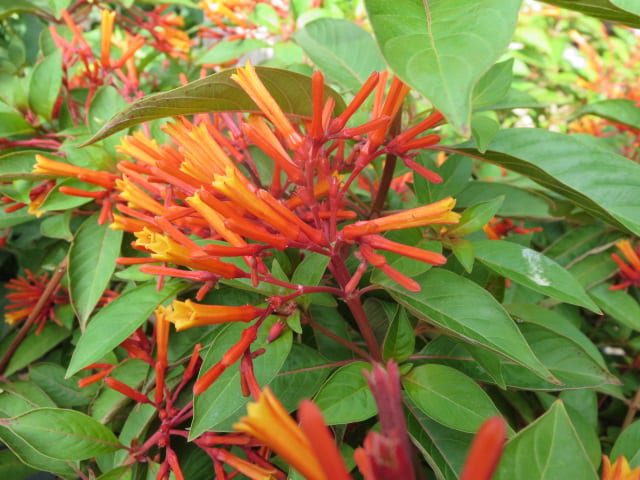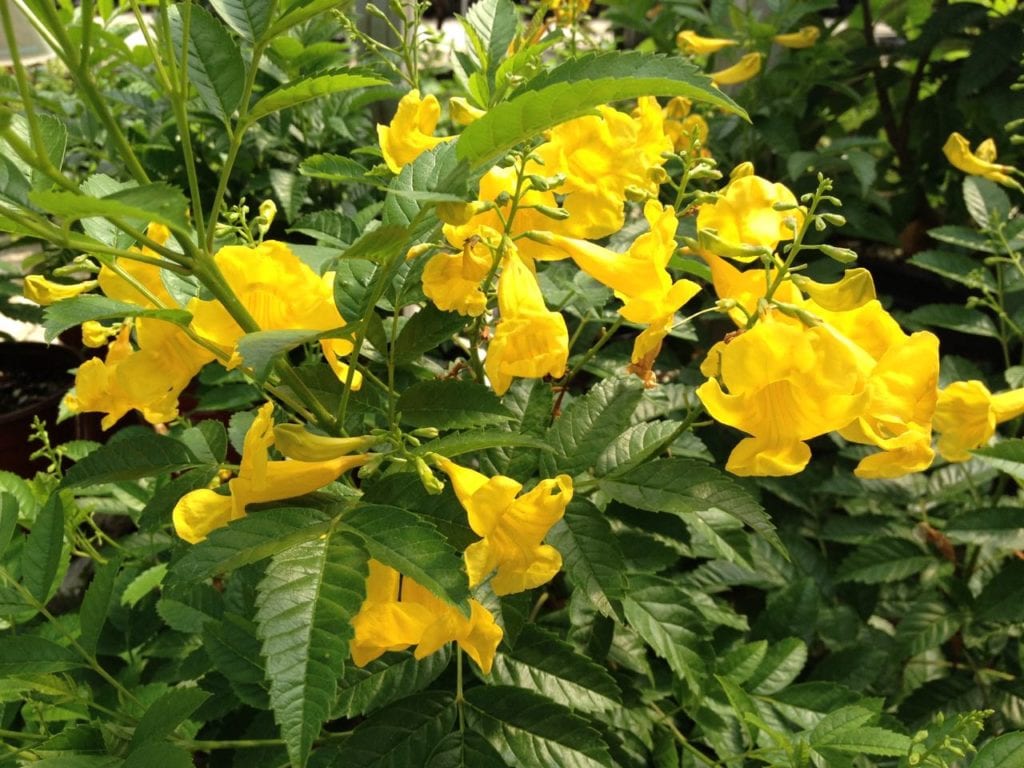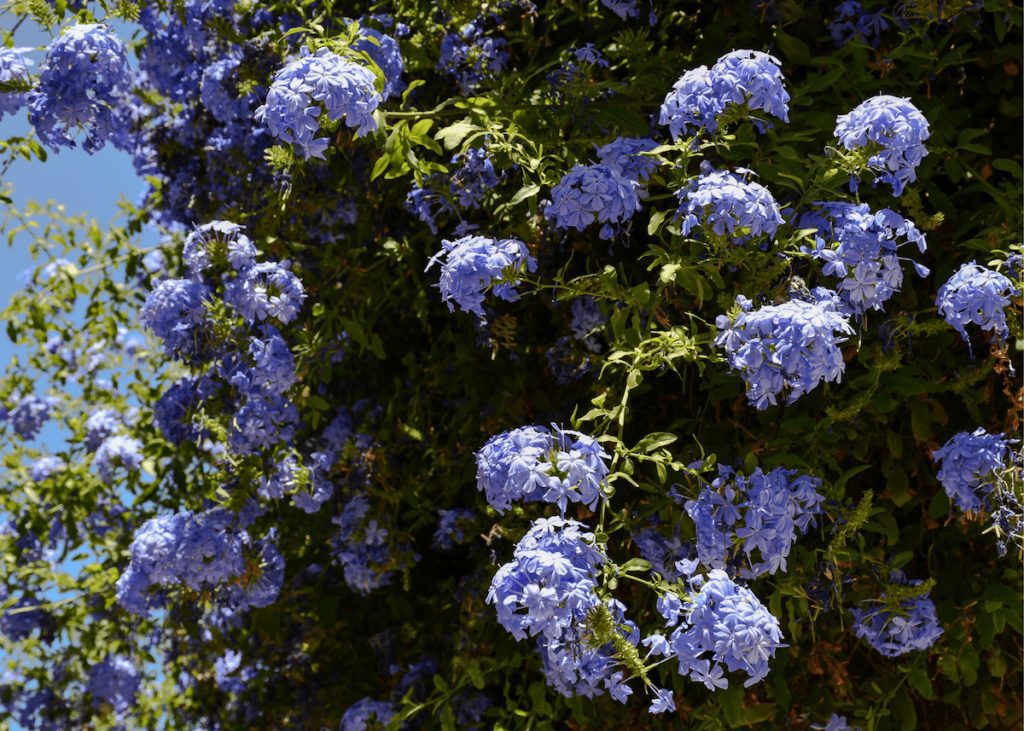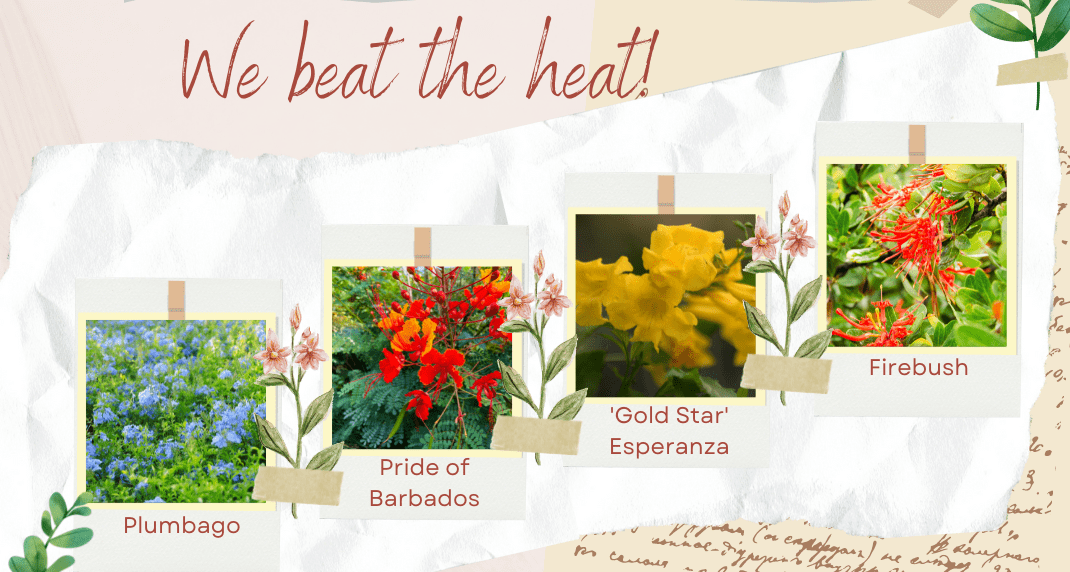Most people know to look for perennial plants that are cold hardy in their region, but here in Texas it’s about as important to look for perennial plants that can withstand our Texas heat. If you’ve ever planted something in spring just to watch it wither and die through summer, you know the pain. This week’s first taste of 90° weather was sure a reminder for me. It’s time to take a look at some of these superstar (literally) perennial plants that beat the heat.
4 Texas Superstar® Perennial Plants for the Heat

Firebush (Hamelia patens): Firebush is a Texas Superstar® perennial plant with a lot to offer. Besides thriving in hot, dry, and sunny places, firebush is a magnet for hummingbirds. The orange-red, tubular flowers cover the entire plant from summer to fall, just when the hummingbirds need them. The flowers aren’t the only color you get with firebush; copper-red foliage develops in summertime and intensifies in fall. Once established, firebush is a very drought-tolerant perennial. Average mature growth for this perennial is 5’ – 6′ tall x wide, but could grow a little bigger so allow it some room in the landscape. Firebush also does well in containers and its size will be smaller. (We even carry dwarf varieties.)

Gold Star Esperanza (Tecoma stans ‘Gold Star’): Yellow, trumpet shaped flowers are profuse on this tropical perennial that can withstand a light frost once established. If you plant ‘Gold Star’ in a sunny location with well-draining soil, you’ll get to enjoy its flowers from summer to frost. Esperanza is a pollinator attracting plant, bringing in butterflies, bees and hummers. ‘Gold Star’ esperanza is a perennial that grows to an average maturity of 5’-7’ tall x 2’-4’ wide. This is a perennial in our area that generally will freeze down to its roots every winter and return with the warmth of spring, growing rapidly through summer.

Plumbago (Plumbago auriculata): A root hardy perennial, plumbago is a very showy plant with clusters of blooms that consist of a multitude of quarter-sized, 5-petaled, powder-blue flowers. These blooms appear continuously all summer long and well into fall. Plumbago seems to do best when offered morning sun and afternoon shade, but I have mine planted in full sun and it does just fine. This perennial adapts to both more or less light, just keep in mind that the denser the shade, the fewer the flowers. Plumbago grows around 3’ tall x wide (sometimes a foot or two wider). Virtually pest and disease free, this Texas Superstar® is also deer resistant.

Pride of Barbados (Caesalpinia pulcherrima): This is without a doubt one of the most sought after perennials once summer gets rolling. People see the fiery, orange-red blossoms that grace the fern-like foliage and come into the nursery describing one of the most beautiful plants they have ever seen. This perennial just makes people want it. Once they learn that it is not bothered by pests or disease, is drought and heat tolerant, a pollinator-attractor, and that deer tend to leave it alone, it skyrockets to the top of their list! Pride of Barbados is another Texas Superstar® perennial that will come back from its roots around mid spring (sometimes a little later). It can get pretty tall depending on growing conditions, 5’-8’ tall x 4′-5′ wide in average San Antonio landscapes. This perennial really starts to take off and grow quickly once the heat arrives. Plant it in a sunny location with well-draining soil and enjoy the show stopping blooms from summer to fall.
While I doubt many of us are looking forward to the hot temperatures, I hope this showcase of “beat the heat” perennials will give you a sunnier outlook for making it through our Texas summers.
~The Happy Gardener, Lisa Mulroy


Brought home a Firecracker plant with lots of red blooms and after planting it seemed to lose all blooms. I trimmed off the dead ends, fed organic food and have been watering almost daily due to heat. It’s in large planter in full sun. Also, brought home flowering vine (can’t remember name) with few flowers. Flowers dropped off. Have fed organic food and watered. Seems to be getting leaves, but no flowers.
Hi Suzanne,
There is a chance that your plants are just going through an adjustment phase. They are adjusting to your new microclimate in your landscape, adjusting to new soil, new watering schedule, new food, etc… Pretty sure with having your firecracker in the sunshine you will get some blooms at some point. Sounds like you are doing everything right. Just double check the soil moisture before you water (stick your finger in about 3 inches and feel for moisture. If moist, skip a watering.)
Not sure about the vine without knowing what it is, but my first guess is that it is adjusting too. It’s hot out and it might take a little while for the adjustment, and roots struggle to get established in the heat.
Our Mexican Fire BGush grows a lot bigger than the specimens you mention. It grows to as high as 7 foot and is huge around. love it. It is in a hot place in our yard and never fails to show itself off and love that afternoon heat.
Hi Linda,
Yes, it does grow bigger. You helped me find a typo, although there is a dwarf variety that stays much more compact! Appreciate your comment (and help), and happy you are loving your firebush!
I have tried both a plumago and a Gold Star esperanza. I planted closer to the house for protection from wind and cold, but lost both to the winter. I live in Blanco so it is colder. Are they not for my garden because of colder? What about Pride of Barbados? Can it take colder temps than the others? Thank you.
While all of these plants generally come back after a mild winter, we’ve had a few winters recently that tipped the scales with some days being colder than usual. According to the 2023 USDA Hardiness Zone Map Blanco County, Texas is in Zones 8b (15°F to 20°F) and 9a (20°F to 25°F). So if you teeter towards the 9a zone, and maybe didn’t mulch the roots of the plants, they could succumb to the winter cold. Sometimes we don’t wait long enough for them to emerge in spring and chalk it up to a dying plant. Pride of Barbados usually is one of the last plants to emerge back from its roots in late, late spring.
So, that all being said. You could try taking some extra winter precautions with all of these plants: mulching, watering thoroughly the day before a freeze, covering with frost cloth, etc… But if you already tried all that and if you are on that edge of the colder zones, they might not be the ones for you. Here is a list of some cold hardy plants that might interest you. Cold Hardy Plants